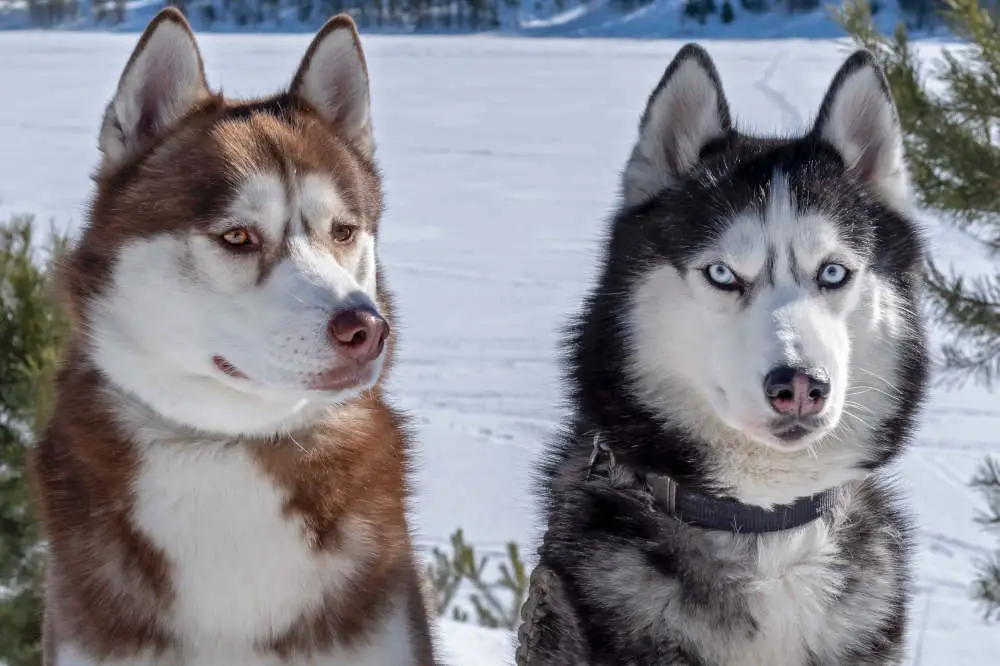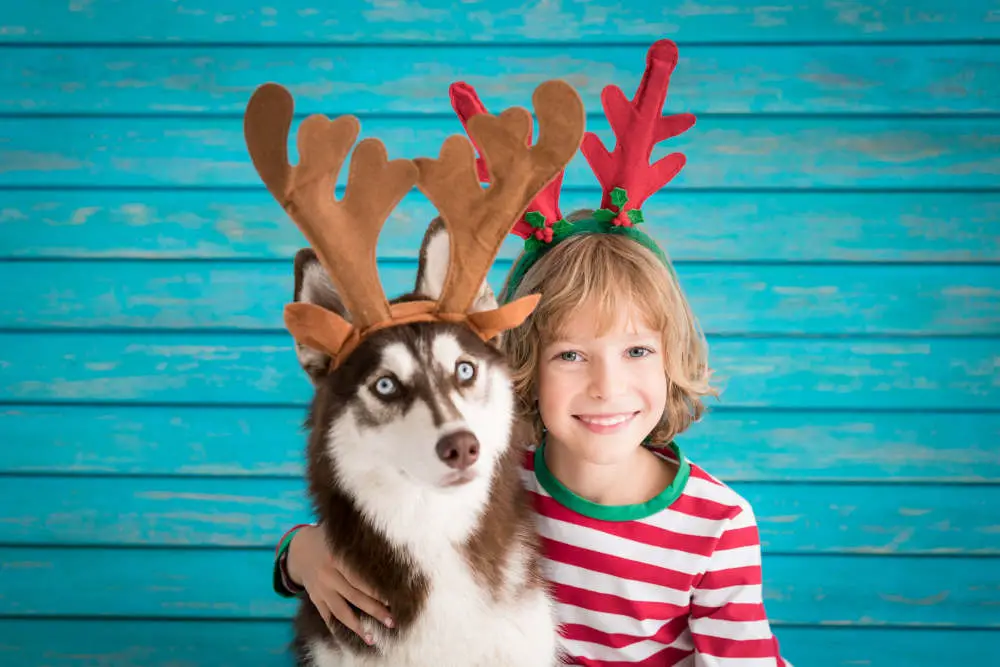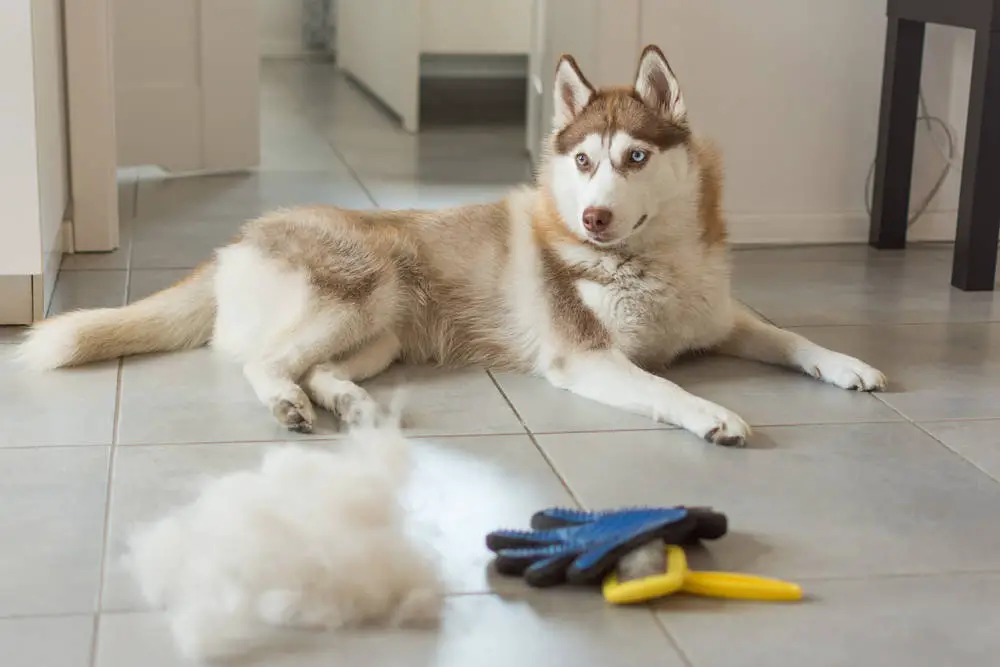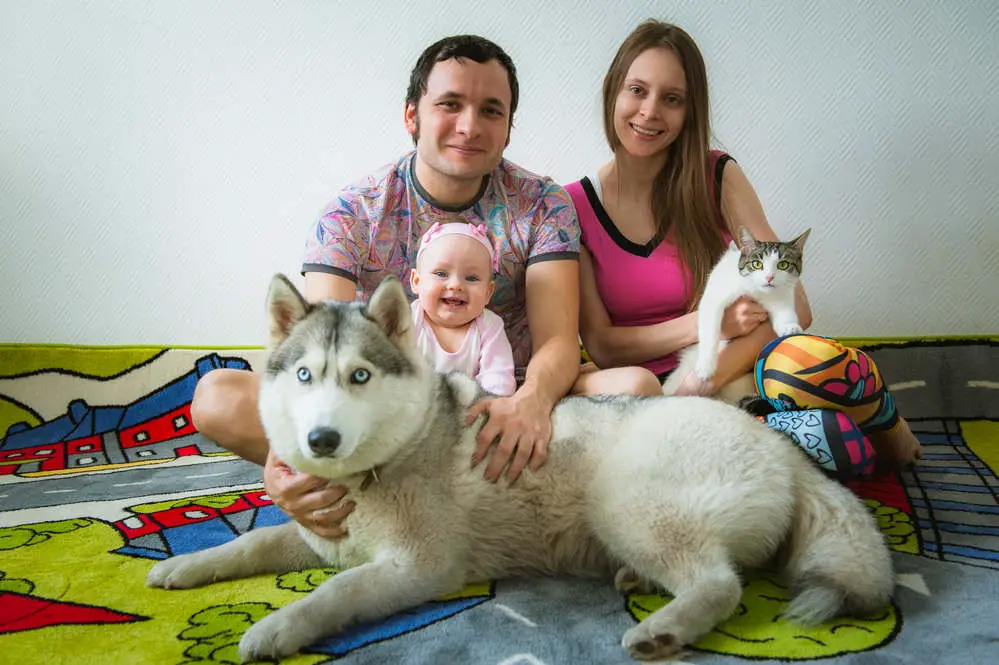
One cannot help but fall in love with the gorgeous Siberian Husky. Characterized by its beautiful, dense coat, icy blue, brown or multi-colored eyes, wolf-like looks and prominent facial mask, the Siberian Husky—as the name suggests—is native to Siberia. The medium size, compactly built athletic dog is intelligent, dignified, loyal, mischievous and friendly, making Huskies wonderful family dogs and companions.
If you’re planning to bring home a Siberian Husky and are wondering whether this dog is right for your family, then read on to know everything about this beautiful breed.
Siberian Husky Breed Overview
- Height: 20 to 23.5 inches
- Weight: 35 to 60 lb
- Lifespan: 12 to 15 years
- Appearance: Compact build, wolf-like looks with a dense coat in black, gray, red and white, white face with markings, triangular erect ears, brush-shaped tail
- Temperament: Outgoing, friendly, playful, intelligent and stubborn
- Suitable For: Active families with kids
History
Originally from Northeast Asia, Siberian Huskies were bred by the Siberian Chukchi people, where they were used as sled dogs to pull loads across the icy expanses. They were also excellent companion dogs that slept with the children in the family and kept them warm on cold nights. This working sled dog belongs to the spitz family and has a compact body, distinct wolf-like looks and resembles the Alaskan Malamute very closely.
Siberian Huskies were introduced to Nome Alaska in 1908 by the Russian fur trader William Goosak during the Nome Gold Rush and they were put to work as sled dogs for expeditions through impenetrable terrains and working in the minefields. Huskies started being recognized by the public in the early 1900s when they began participating in and winning sled races.
Related: Husky Doberman Mix Breed Profile
However, they became popular in 1925, when a pack of Huskies led by Leonhard Seppala, a renowned musher carried life-saving serum to Nome in just 5.5 days during a diphtheria epidemic. In fact, the statue of Balto, the lead Husky of the serum run, was erected in Central Park in 1925 to honor the canine hero.
The AKC recognized the Siberian Husky in 1930 and is ranked as the 12th most popular dog breed. Today, the Siberian Huskies are popular as household pets and companion dogs, although they are still used as sled dogs for fun and sport across North America by recreational, as well as competitive mushers.
Related: 44 of the Most Beautiful Husky Mix Breeds
Appearance
When you think about a Siberian Husky, the first words that come into your mind are “stunning”, “striking”, “gorgeous” (in short, wow!). Characterized by their piercing, almond-shaped eyes in blue, brown, amber color or bi-eyes (one blue and one brown eye) or parti-eyes (half blue and half brown eyes), white mask-like faces with distinctive markings, an alert, intelligent expression, fox-like brush-shaped tail and triangular erect ears, the Husky is indeed unique.
Related: Can Huskies Have Brown Eyes?
The breed has a dense double coat, with a thick and straight outer coat and a short, soft and downy undercoat that provides insulation and keeps the dog warm. The coat comes in various colors such as black, gray, all-white, red, sable and agouti with white markings on the legs, underbelly and tail, as well as combinations of black and white, gray and white and red and white. Built for endurance and speed, this compact breed is nimble-footed and quick and is around 20 to 23.5 inches tall and weighs around 35 to 60 lb.
Related: When Do Huskies Stop Growing?
Temperament

The Siberian Husky is an intelligent, independent, outgoing, friendly and highly active dog. If you are an active family with kids, then the Husky with its eager attitude and playful disposition is a great pet for you. He is ever ready to go on a long walk, jog, run around and play in the yard or pull a wagon full of children.
Innately very friendly, the Husky will welcome any person (including intruders) coming to your home with a friendly sniff and tail wag and so is a definite “no-no” if you’re looking for a fierce guard dog. While the Husky doesn’t aim to please, he simply loves the company of family, kids and does quite well with other dogs at home.
A working dog at heart, the Husky is happiest when he is busy doing tasks. Left alone for long periods, without anything to do can make your furry pet anxious and fretful. While Huskies don’t bark a lot, they are rather talkative, whining and moaning to get your attention. They also howl like wolves when they meet other Huskies, hear sirens or as just a way to greet you in the morning.
This may get annoying after a while, especially if you live in an apartment and you need to train your Husky to stop howling at your command. The Husky is a highly energetic breed and if he does not have things to do or get adequate exercise, he can get bored and rather destructive. And, if left alone, you may get back home to find all your plants and flowers dug up, furniture, footwear and even your wall chewed through.
Also Read: Husky Shiba Inu Mix Breed Profile
Also, avoid leaving your Husky outdoors in the yard by himself—he has not been called “Houdini hound” for nothing. The Husky is a talented escape artist and can find weak spots in your fence or any containment and get out.
Make sure that your garden or yard has a high fence, which goes into the ground so that your pooch cannot dig himself out from under the fence and escape. Also, keeping your pet busy and ensuring that he has ample exercise can help to reduce boredom and destructive behaviors.
Also Read: Do Huskies Like to Cuddle?
Children and Other Pets
Siberian Huskies are great family companions and pets, especially with homes with kids. They are tolerant of kids; however, you must ensure that the playtime between your dog and younger kids must be supervised. Teach your kids how to approach, touch and play with your Husky and discourage them from pulling your pet’s tail or ears or indulge in any rough play.
Also, make sure that your kids understand that they should leave your pet alone when he’s eating and never try to take away his food. While Huskies may be tolerant to other dogs at home, they may view other smaller pets such as cats, rabbits, squirrels, etc. as prey.
And, early socialization can help your Husky puppy to get used to your children, people, other dogs and pets at home. Nevertheless, Huskies do quite well in homes with several pets, especially if they have been raised along with other pets from when they were young.
Health
In general, Siberian Huskies are quite a healthy breed and they have a lifespan of around 12 to 15 years. A healthy, nutritious diet and adequate exercise can help him stay lean, fit and healthy. However, Huskies may be prone to certain health conditions.
Typically, responsible and reputable breeders endeavor to maintain the breed standards that have been established by respected kennel clubs such as the American Kennel Club. However, there may be certain hereditary and other health issues that can occur in the breed.
And, if you’re planning to bring home a Husky, then it is important to be aware of the health problems that can affect this breed. Some health issues faced by Siberian Huskies include:
- Hip Dysplasia: This is a condition that may be either genetic or develop over time, which is characterized by the abnormal formation of the hip socket. In hip dysplasia, either the cartilage may wear away between the bones or the thigh bone may not fit into the hip socket properly and as a result, create painful arthritis.
- Hypothyroidism: In this, the thyroid gland does not produce sufficient hormones.
- Progressive Retinal Atrophy (PRA): PRA is a degenerative eye disorder where the photoreceptors from the back of the eye are lost, causing blindness.
- Cataracts: This is when the lens of the eye becomes opaque, giving the eye(s) a cloudy appearance, causing problems in vision.
- Corneal Dystrophy: This is when the cornea i.e., the transparent part of the eyeball becomes opaque, which is caused because of the accumulation of lipids in the cornea.
The breed also may suffer from problems like epilepsy, laryngeal paralysis, hemophilia and zinc responsive dermatosis.
Related: Can Huskies Live in Hot Weather?
Grooming and Maintenance

As discussed earlier, the Siberian Husky has a dense double coat, which is quite easy to groom and maintain. They are quite clean dogs without the typical doggy odor and only require a few baths in a year because excessive bathing can cause the skin of the Husky to dry out. Also, when bathing your Husky, you must take care to rinse and dry the undercoat thoroughly otherwise the skin can get damaged.
Make sure to use a high-quality dog shampoo that will help to retain all the natural oils in your pet’s skin and coat, leaving it soft, healthy and shiny. A thorough regular brushing helps to keep your Husky’s coat well-groomed and in good condition. The Husky is a moderate shedder and especially sheds very heavily twice in a year, i.e., fall and spring.
Make sure to brush your pooch’s teeth 2-3 times a week to prevent any bacteria and remove the buildup of tartar. Brushing your Husky’s teeth daily can keep bad breath and gum disease at bay. Check your pet’s ears regularly and clean them by wiping them with a cotton ball dipped in a gentle ear cleaner to prevent any infections. Trim your pet’s nails 1-2 times a month.
Exercise Needs
Siberian Huskies were bred to be active and they are athletic dogs, requiring plenty of vigorous activity to be healthy and fit. If these dogs do not get their daily dose of exercise, they can become rowdy and quite destructive.
It is important to keep your Husky physically, as well as mentally stimulated for them to be their happiest. Around 30-60 minutes of vigorous exercise every day is sufficient to keep your Husky satiated and happy. While they make excellent jogging or hiking partners, you must take care not to exercise your pet in hot weather because they cannot tolerate the heat.
Just a small garden or yard is enough for your Husky to burn all his pent-up energy. A Husky loves nothing more than doing activities with his human, which not only keeps him active and fit but also helps to strengthen the dog-owner bond. Originally bred as a sled puller, Huskies can run and every opportunity that your pooch finds, he will run. So, it is essential to keep your Husky in a fenced yard, in harness or on a leash whenever he’s outdoors.
Also Read: Why Is My Husky So Fat?
Training
While any dog breed does well with training, it is especially a must with a Husky and it may be worthwhile investing in advanced training, socialization and obedience classes for your pooch.
However, your wilful and intelligent Husky knows his way around. While he may go through all his training classes and ace it with flying colors, he may become quite tenacious at home and revert to his stubborn ways.
Leash training is also very important for your Husky and if the area is not fenced, then you should not let your pet off his leash. Since Huskies love to run, he will do so the minute he gets an opportunity and if he decides to simply do a runner, then you could easily lose your dog. Also, Huskies have a strong prey drive and so it is better to have them on a leash while walking outdoors or he could dash off after a small animal.
The Husky’s wilful temperament can make them rather difficult to train. They may not be the ideal pets for first-time dog owners as they may find it difficult to control their wilful pet. Huskies need experienced owners who can assert themselves as the leader, be firm and consistent with them. Nevertheless, with some time, patience and perseverance, this is sure to pay off in the end and you’ll have a well-trained and obedient Husky.
Diet Needs
For their size, Huskies surprisingly need quite a small amount of food. This feature probably goes back to the breed’s origins, where the Chukchi people used Huskies to pull small loads over long distances in very cold temperatures on very small portions of food.
Your Husky will do quite well with his daily recommended amount of food of 1.5-2 cups of good quality dry food, divided into 2 meals in a day. However, the amount of food your pooch eats essentially depends on his size, build, age, activity and metabolism level.
Related: Why Does My Husky Hide Food?
Should You Bring Home a Siberian Husky?

After reading all the information about Siberian Huskies, you’re sure to have fallen in love with one. However, it is important to understand that while the Husky may be a fantastic dog breed, they may not necessarily be the best pet for you and your family. And so, before you make your decision of whether to bring home a Husky or not, take a look at the various pros and cons.
Pros
- Huskies are gentle dogs and they are friendly, easygoing and get along with people of all ages, kids and also other pets at home.
- Huskies are generally healthy and have a very low susceptibility to hereditary diseases.
- This is a very clean breed that is quite easy to maintain.
- Huskies are intelligent dogs and fairly easy to socialize and train.
Cons
- These dogs shed moderately all through the year and shed quite heavily twice a year in fall and spring when they blow their coats.
- They are quite talkative and are quite vocal, moaning, whining and howling quite loudly, which can be rather annoying to your neighbors.
- Huskies are highly energetic and active dogs and need quite a lot of exercise.
In conclusion, the amazing Husky is a spirited dog breed that is not only stunning to look at, but its intelligence, easygoing, playful and friendly temperament and various qualities make this dog breed a great addition to any home.
However, these dogs can be quite difficult to handle, especially for first-time owners and may do better with experienced dog owners. Nevertheless, if properly trained, Siberian Huskies can make excellent family companions. So, it’s a good idea to give it a good thought before bringing home a Siberian Husky.
